Products >> PCB manufacturing
Printed circuit direct current around their surface through a network of copper pathways.The complex system of copper routes determines the unique role of each piece of electronic board.Printed Circuit Boards -PCB form the backbone of all major electronic product. And the PCBs used in nearly all computational electronics, From the simple devices like digital clocks, calculators etc. A Printed circuit board routes electrical signals through electronics, which satisfies the device's electrical and mechanical circuit requirements. In short, PCB tell the electricity where to go, bringing your electronics to life.

PCB Manufacturing Process Steps
Step 1: PCB Layout and Output
Electronic boards should be rigorously compatible with, a PCB layout created by the designer using PCB design software. Commonly-used PCB design software includes Eagle,Altium Designer, OrCAD, Pads, KiCad, etc.
NOTE: The most common used PCB software by the PCB Manufacturer is AD DXP PROTEL CMA350 PADS ect,Before PCB manufacturing, designers should inform their contract manufacturer about the PCB design software version used to design the circuit since it helps avoid issues caused by discrepancies.
Once the PCB design is approved for production, designers export the design into format their manufacturers support. The most frequently used program is called extended Gerber.Gerber also goes by the name IX274X.Different generation of Gerber software,They all encode comprehensive vital information including copper tracking layers, drill drawing, apertures, component notations and other options.All aspects of the PCB design undergo checks at this point. The software performs oversight algorithms on the design to ensure that no errors go undetected. Designers also examine the plan with regard to elements relating to track width, board edge spacing, trace and hole spacing and hole size.
After a thorough examination, designers forward PCB file to PCB Fabricator for manufacturing. To ensure the design fulfills requirements for the minimum tolerances during manufacturing process, almost all PCB manufacturer run Design for Manufacture (DFM) check before circuit boards fabrication.
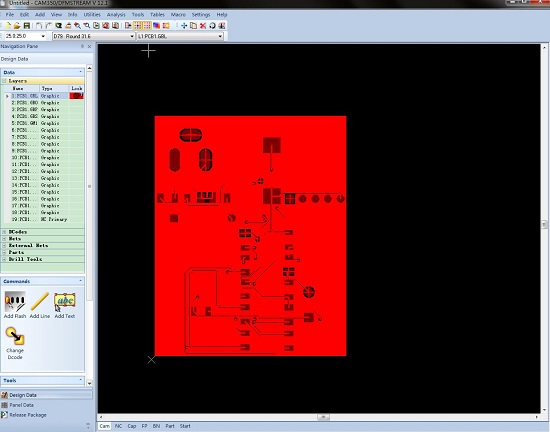
Step 2: From File to Film- map out a figure of copper path
The PCB manufacturers use a special printer called a plotter, which makes photo films of the PCBs, to print circuit boards. Manufacturers will use the films to image the PCBs. Although it's a laser printer, it isn't a standard laser jet printer. Plotters use incredibly precise printing technology to provide a highly detailed film of the PCB design.
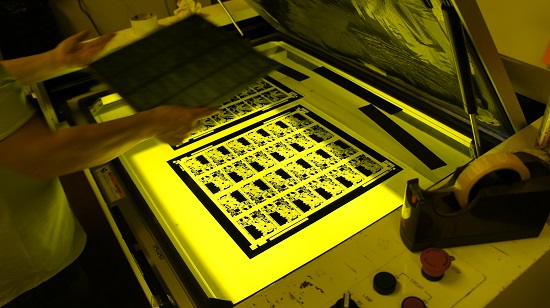 Film
Film
The final product results in a plastic sheet with a photo negative of the Printed circuit board in black ink. For the inner layers of PCB circuit, black ink represents the conductive copper parts of the PCB. The remaining clear portion of the image denotes the areas of non-conductive material. The outer layers follow the opposite pattern: clear for copper, but black refers to the area that'll be etched away. The plotter automatically develops the film, and the film is securely stored to prevent any unwanted contact.
Each layer of PCB (Printed circuit board) and solder mask receives its own clear and black film sheet. In total, a two-layer PCB board needs four sheets: two for the layers and two for the solder mask. Significantly, all the films have to correspond perfectly to each other. When used in harmony, they map out the PCB alignment.To achieve perfect alignment of all films, registration holes should be punched through all films. The exactness of the hole occurs by adjusting the table on which the film sits. When the tiny calibrations of the table lead to an optimal match, the hole is punched. The holes will fit into the registration pins in the next step of the imaging process.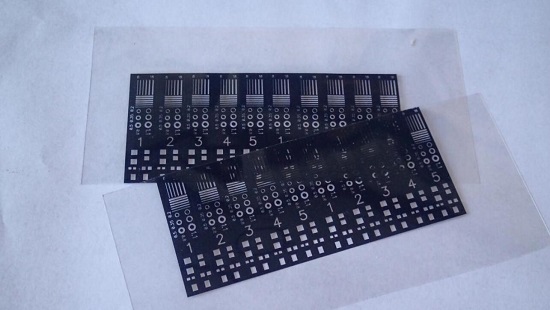 Film
Film
Step 3: Making the Inner layers - Print the figure on the film onto a copper foil.
This step in PCB fabricating prepares to make actual Printed circuit board. The basic form of PCB (printed circuit board) comprises a laminate board whose core material is epoxy resin and glass fiber that are also called substrate material. Laminate serves as an ideal body for receiving the copper that structures the PCB. Substrate material provides a sturdy and dust-resistant starting point for the PCB. Copper is pre-bonded on both sides. The process involves whittling away the copper to reveal the design from the films.
In PCB (printed circuit board) construction, cleanliness does matter. The copper-sided laminate is cleaned and passed into a decontaminated environment. During this stage, it's vital that no dust particles settle on the laminate. An errant speck of dirt might otherwise cause a circuit to be short or remain open.
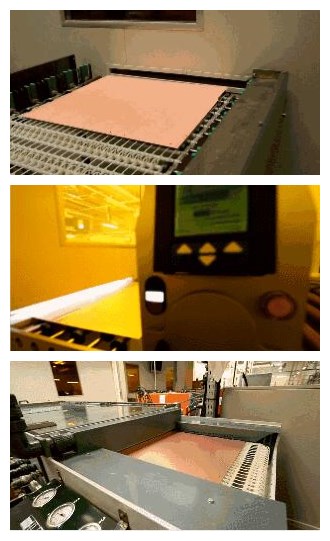 The copper-sided laminate clean
The copper-sided laminate clean
Next, the clean panel receives a layer of photo-sensitive film called photo resist. The photo resist comprises a layer of photo reactive chemicals that harden after exposure to ultra violet light. This ensures an exact match from the photo films to the photo resist. The films fit onto pins that hold them in place over the laminate panel.The film and board line up and receive a blast of UV light. The light passes through the clear parts of the film, hardening the photo resist on the copper underneath. The black ink from the plotter prevents the light from reaching the areas not meant to harden, and they are slated for removal.

After the PCB board becomes prepared, it is washed with an alkaline solution that removes any photo resist left unhardened. A final pressure wash removes anything else left on the surface. The board is then dried.
The product emerges with resist properly covering the copper areas meant to remain in the final form. A technician examines the boards to ensure that no errors occur during this stage. All the resist present at this point denotes the copper that will emerge in the finished PCB(printed circuit board).This step only applies to boards with more than two layers. Simple two-layer boards skip ahead to drilling. Multiple-layer boards require more steps.
Step 4: Removing the Unwanted Copper
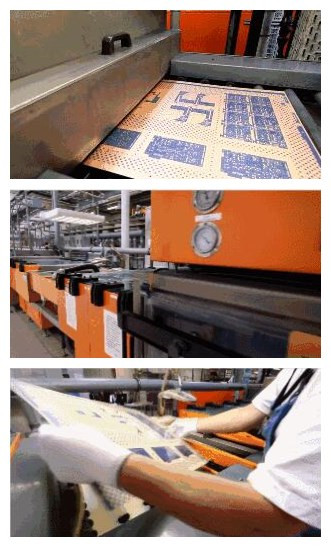
With the photo resist removed and the hardened resist covering the copper we wish to keep, the board proceeds to the next stage: unwanted copper removal. Just as the alkaline solution removed the resist, a more powerful chemical preparation eats away the excess copper. The copper solvent solution bath removes all of the exposed copper. Meanwhile, the desired copper remains fully protected beneath the hardened layer of photo resist.
Not all copper boards are created equal. Some heavier boards require larger amounts of copper solvent and varying lengths of exposure. As a side note, heavier copper boards require additional attention for track spacing. Most standard PCBs rely on similar specification.

Now that the solvent removed the unwanted copper, the hardened resist protecting the preferred copper needs washing off. Another solvent accomplishes this task. The board now glistens with only the copper substrate necessary for the PCB.
Step 5: Layer Alignment and Optical Inspection
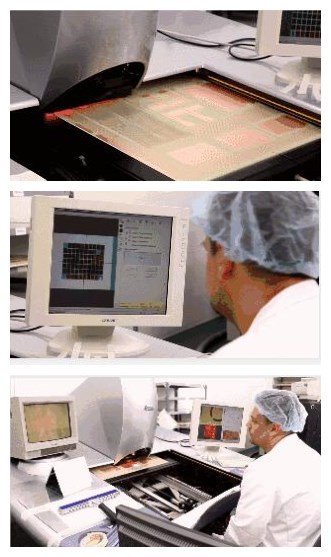
With all the layers clean and ready, the layers require alignment punches to ensure they all line up. The registration holes align the inner layers to the outer ones. The technician places the layers into a machine called the optical punch, which permits an exact correspondence so the registration holes are accurately punched.
Once the layers are placed together, it's impossible to correct any errors occurring on the inner layers. Another machine performs an automatic optical inspection of the panels to confirm a total absence of defects. The original design from Gerber, which the manufacturer received, serves as the model. The machine scans the layers using a laser sensor and proceeds to electronically compare the digital image with the original Gerber file.
If the machine finds inconsistency, the comparison is displayed on a monitor for the technician to assess. Once the layer passes inspection, it moves to the final stages of PCB production.
Step 6: Layer-up and Bond
In this stage, the circuit board takes shape. All the separate layers await their union. With the layers ready and confirmed, they simply need to fuse together. Outer layers must join with the substrate. The process happens in two steps: layer-up and bonding.
The outer layer material consists of sheets of fiber glass, pre-impregnated with epoxy resin. The shorthand for this is called prepreg. A thin copper foil also covers the top and bottom of the original substrate, which contains the copper trace etchings. Now, it's time to sandwich them together.
The bonding occurs on a heavy steel table with metal clamps. The layers securely fit into pins attached to the table. Everything must fit snugly to prevent shifting during the alignment.
A technician begins by placing a prepreg layer over alignment basin. The substrate layer fits over the prepreg before the copper sheet is placed. Further sheets of prepreg sit on top of the copper layer. Finally, an aluminum foil and copper press plate complete the stack. Now it's prepped for pressing.
The entire operation undergoes an automatic routine run by the bonding press computer. The computer orchestrates the process of heating up the stack, the point in which to apply pressure, and when to allow the stack to cool at a controlled rate.
Next, a certain amount of unpacking occurs. With all the layers molded together in a super sandwich of PCB glory, the technician simply unpacks the multi-layer PCB product. It's a simple matter of removing the restraining pins and discarding the top pressure plate. The PCB goodness emerges victorious from within its shell of aluminum press plates. The copper foil, included in the process, remains to comprise the outer layers of the PCB. 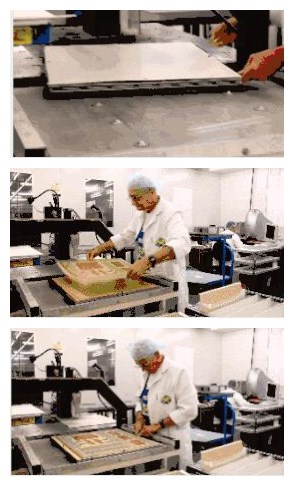
Step 7: Drilling
Finally, holes are bored into the stack board. All components slated to come later, such as copper-linking via holes and leaded aspects, rely on the exactness of precision drill holes. The holes are drilled to a hairs-width - the drill achieves 100 microns in diameter, while hair averages at 150 microns.
To find the location of the drill targets, an x-ray locator identifies the proper drill target spots. Then, proper registration holes are bored to secure the stack for the series of more specific holes.
Before drilling, the technician places a board of buffer material beneath the drill target to ensure a clean bore is enacted. The exit-material prevents any unnecessary tearing upon the drill's exits.
A computer controls every micro-movement of the drill - it's only natural that a product that determines the behavior of machines would rely on computers. The computer-driven machine uses the drilling file from the original design to identify the proper spots to bore.
The drills use air-driven spindles that turn at 150,000 rpm. At this speed, you might think that drilling happens in a flash, but there are many holes to bore. An average PCB contains well over one hundred bore intact points. During drilling, each needs its own special moment with the drill, so it takes time. The holes later house the vias and mechanical mounting holes for the PCB. The final affixation of these parts occurs later, after plating.
Step 8: Plating and Copper Deposition
After drilling, the panel moves onto plating. The process fuses the different layers together using chemical deposition. After a thorough cleaning, the panel undergoes a series of chemical baths. During the baths, a chemical deposition process deposits a thin layer - about one micron thick - of copper over the surface of the panel. The copper goes into the recently drilled holes.
Prior to this step, the interior surface of the holes simply exposes the fiber glass material that comprises the interior of the panel. The copper baths completely cover, or plate, the walls of the holes. Incidentally, the entire panel receives a new layer of copper. Most importantly, the new holes are covered. Computers control the entire process of dipping, removal and procession.

Step 9: Outer Layer Imaging
In Step 3, we applied photo resist to the panel. In this step, we do it again - except this time, we image the outer layers of the panel with PCB design. We begin with the layers in a sterile room to prevent any contaminants from sticking to the layer surface, then apply a layer of photo resist to the panel. The prepped panel passes into the yellow room. UV lights affect photo resist. Yellow light wavelengths don't carry UV levels sufficient to affect the photo resist.
Black ink transparencies are secured by pins to prevent misalignment with the panel. With panel and stencil in contact, a generator blasts them with high UV light, which hardens the photo resist. The panel then passes into a machine that removes the unhardened resist, protected by the black ink opacity.
The process stands as an inversion to that of the inner layers. Finally, the outer plates undergo inspection to ensure all of the undesired photo resist was removed during the previous stage.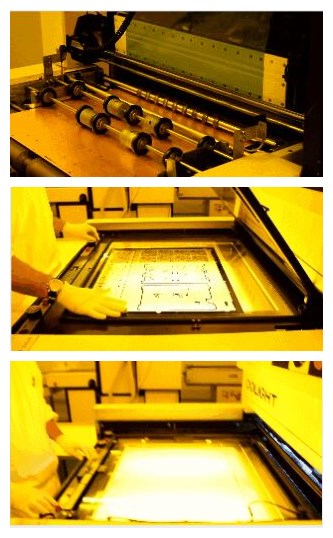
Step 10: Plating
We return to the plating room. As we did in Step 8, we electroplate the panel with a thin layer of copper. The exposed sections of the panel from the outer layer photo resist stage receive the copper electro-plating. Following the initial copper plating baths, the panel usually receives tin plating, which permits the removal of all the copper left on the board slated for removal. The tin guards the section of the panel meant to remain covered with copper during the next etching stage. Etching removes the unwanted copper foil from the panel.
Step 11: Final Etching
The tin protects the desired copper during this stage. The unwanted exposed copper and copper beneath the remaining resist layer undergo removal. Again, chemical solutions are applied to remove the excess copper. Meanwhile, the tin protects the valued copper during this stage.The conducting areas and connections are now properly established.
Step 12: Solder Mask Application
Before the solder mask is applied to both sides of the board, the panels are cleaned and covered with an epoxy solder mask ink. The boards receive a blast of UV light, which passes through a solder mask photo film. The covered portions remain unhardened and will undergo removal.Finally, the board passes into an oven to cure the solder mask.
Step 13: Surface Finish
To add extra solder-ability to the PCB, we chemically plate them with gold or silver. Some PCBs also receive hot air-leveled pads during this stage. The hot air leveling results in uniform pads. That process leads to the generation of surface finish. PCBCart can process multiple types of surface finish according to customers' specific demands.
Step 14: Silkscreen
The nearly completed board receives ink-jet writing on its surface, used to indicate all vital information pertaining to the PCB. The PCB finally passes onto the last coating and curing stage.
Step 15: Electrical Test
As a final precaution, a technician performs electrical tests on the PCB. The automated procedure confirms the functionality of the PCB and its conformity to the original design. At PCBCart, we offer an advanced version of electrical testing called Flying Probe Testing, which depends on moving probes to test electrical performance of each net on a bare circuit board.
Step 16: Profiling and V-Scoring
Now we've come to the last step: cutting. Different boards are cut from the original panel. The method employed either centers on using a router or a v-groove. A router leaves small tabs along the board edges while the v-groove cuts diagonal channels along both sides of the board. Both ways permit the boards to easily pop out from the panel.
Products Category
- PCB Design & Layout
- PCB manufacturing
- PCB Assembly
- BGA Assembly
- THT Assembly
- SMT Assembly
- Mixed PCB Assembly in Electronic PCBA
- Single sided PCB assembly
- Double sided PCB assembly
- Rigid-Flex Assembly
- COB Bonding Manufacturing
- Components sourcing for PCB Assembly
- SMT Stencils
- Box build assembly
- PCB engineer reverse
Contact Us
E-mail: [email protected]
E-mail: [email protected]
Skype: [email protected]
Whatsapp: +86 15012972502
Add: 2F, BUILDING H, WANDA INDUSTRIAL ZONE, ZHOUSHI ROAD, LANGXIN COMMUNITY,SHIYAN STREET, BAO 'AN DISTRICT, SHENZHEN, GUANGDONG, CHINA







 Skype Chat
Skype Chat WhatsApp
WhatsApp  Mail inquiry
Mail inquiry